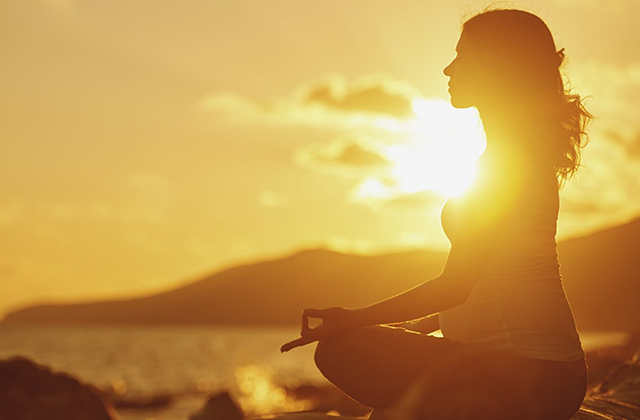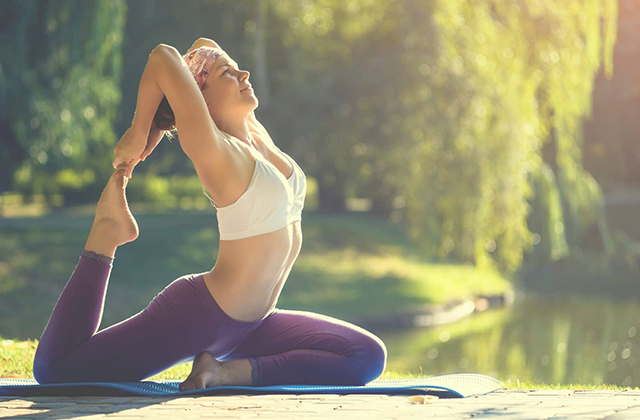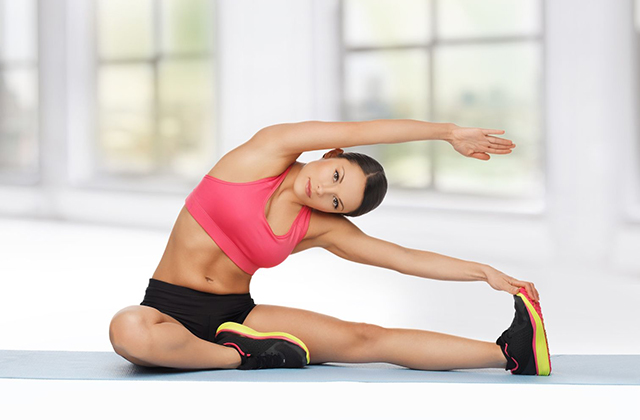Reformer Pilates manly are excellent at helping to keep the neck & back protected whilst still offering amazingly transformational exercises. Last week, I promised you some surprising scientific evidence on stretching. Here are the findings from studies on stretching that were conducted at universities in Canada, the United States and the United Kingdom.
Finding # 1. Active and dynamic stretching are both better at increasing flexibility than is passive stretching. You stretch passively when you use your hand, the floor or a piece of exercise equipment to create the stretch. You stretch actively when you enlist the muscles on the other side of those being stretched – termed the “agonist” muscles – to form your stretch as shown as the picture at the right. In this illustration the hamstring and glute muscles on the back of the leg are stretching the thigh and hip flexor muscles on the front of the leg. You stretch dynamically when your agonist muscles create little pulses of movement to deepen the stretch on the other (“antagonist”) side. In this example, small contractions of the hamstring and glutes drawing your leg back dynamically stretches your thigh and hip flexor muscles.
The studies concluded that passive stretching is good at relaxing your body but is not very good at increasing range of motion. The largest increases in flexibility came in studies during which subjects performed a combination of active and dynamic stretches and saved the passive stretches for the cool-down. Yoga, with its focus on surrender, is mostly composed of passive stretches. Pilates uses mostly active stretches and so is better at increasing range of motion than is yoga. The Bar Method fuses strength work together with active and dynamic stretching. Look closely at its strength exercises and you’ll notice that they double as active/dynamic stretches for the flip-side, or agonist, muscles.
At the ballet bar students pit strength against length for the muscles of their legs, as shown in the photo above.
Later on mats, Bar Method students form dynamic and active stretches
for their backs as they hold the fronts of their torsos in a flexed
position or perform tiny forward bends at the waist which strengthen
their abs as seen to the left. Finally, the Bar Method inserts a passive
stretch sequence as seen below at the end of every active one. The
warm, exhausted muscles just worked surrender more wholly to the passive
stretches than they would if they had not just been worked. In this
way, the Bar Method’s passive stretches act more deeply than many yoga
stretches performed with muscles that are fresh. Coming at the end of
dynamic stretching sets, these passive stretches also give students a
moment to gently reinforce any increased range of motion they’ve just
gained.
Finding # 2. You don’t have to hold a stretch for very long to get the maximum benefit. One study in Montreal found that 15 to 30 second stretches work best to lengthen muscles. Holding stretches for longer – or repeating them too often – either did nothing at all or had the unpleasant effect of re-tightening those muscles. This finding suggests that yoga classes that give holding pose for longer than a minute could be tightening, not lengthening their students’ muscles. In another study based in Toledo, Ohio two groups stretched their hamstring muscles for different lengths of time, one for 30 seconds and the other for 10 seconds repeated three times. After six weeks, the range of motion gains were equal in both groups. The evidence in favor of shorter stretches is strong. If you’re aiming for a more flexible body, yoga’s long, unbroken holds have no advantage over numerous shorter ones, and can even be counterproductive.
Finding # 3. Strength and Stretch are part of one continuum, not separate features of fitness. Picture a yogi or a contortionist. Your mind will probably conjure up a slender, fragile figure. Now imagine a body-builder or football player. Odds are you’ll be seeing a tight, muscle-bound physique. In actuality these stereotypes represent extremes of body-type, not end results from physical regimes. For us average body types, the first step in stretching one of our muscles is to strength it. Our stronger muscle will in turn add stability to its underlying joint, making it less likely that the joint will fly out of control and get injured (joints are smart). Then, and only then, the joint allows our muscle to increase its range of motion.
When in my 30’s I started taking The Lotte Berk Method, the predecessor of the Bar Method. I was a regular yoga student but had been frustrated by the lack of gain in my flexibility. I even daydreamed of an operation that would add some length to my tight muscles. The new workout, which greatly strengthened my muscles, almost immediately began giving me more flexibility. Today I can do the splits and back-bends that were once fantasies.
The flip side of this equation is the strength you get from becoming flexible. Simply stated, stretching makes you stronger by giving muscles more ability to both contract and expand. So unless you’re a body-builder solely into fitness to look pumped, you have every reason to add range of motion to your hard-won strength. That range of motion will translate into greater strength during performance, whether you’re lunging for a long-shot on the tennis court or running in a marathon.
Finding #4: Stretching does indeed make muscles look long and lean. No, this is not a myth. Muscles that get stretched as well as strengthened look visibly smaller than solely “pumped” ones. These same muscles are just a strong as their heftier looking counterparts, but they’ll lie closer to the bone and appear smoother.
Taking all evidence into consideration makes it clear that any strength workout worth its salt must not just throw a few passive stretches in at the end but must instead fully integrate flexibility training into its routine.
With 23 exercise studios and Exercise DVDs, The Bar Method represents one of the fastest growing exercise trends in America today. To find out more about the studios, go to http://www.BarMethod.com To read about and purchase the DVDs go to
Article Source: https://EzineArticles.com/expert/Burr_Leonard/206894
Article Source: http://EzineArticles.com/2185726



